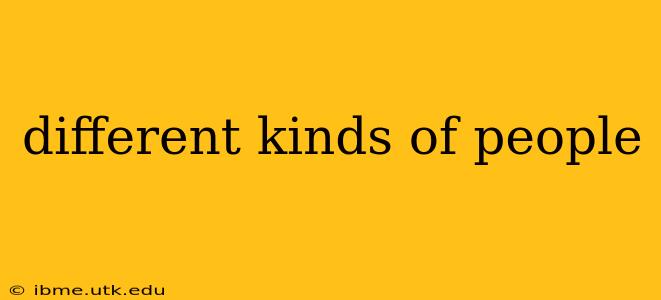Decoding the Diverse Tapestry of Humanity: Exploring Different Kinds of People
We often categorize people, sometimes consciously, sometimes unconsciously. This categorization, while sometimes simplistic, can help us understand the vast spectrum of human experience and interaction. But it's crucial to remember that these are broad strokes, and individuals are far more complex than any label can capture. This exploration will delve into various ways we categorize people, highlighting both the usefulness and limitations of such classifications.
What are the main personality types?
Understanding personality types helps us navigate social interactions and self-awareness. While numerous models exist, the Myers-Briggs Type Indicator (MBTI) and the Big Five personality traits are popular frameworks. MBTI categorizes individuals based on four dichotomies: Introversion/Extraversion, Sensing/Intuition, Thinking/Feeling, and Judging/Perceiving. This results in 16 distinct personality types, each with unique strengths and weaknesses. The Big Five model focuses on five broad dimensions: Openness, Conscientiousness, Extraversion, Agreeableness, and Neuroticism. These models offer valuable insights into how individuals approach the world, but it's vital to remember they are not definitive or exhaustive. Individual personalities are nuanced and evolve throughout life.
What are the different types of human beings?
This question often evokes considerations beyond personality. We can categorize people based on various factors like:
-
Socioeconomic Status: This encompasses factors like income, education, and occupation, significantly impacting access to resources and opportunities. Understanding socioeconomic disparities is vital for addressing social inequality.
-
Cultural Background: Culture shapes our values, beliefs, and behaviors. Exploring diverse cultures enriches our understanding of the world and fosters empathy. Cultural background influences everything from communication styles to family structures.
-
Age and Life Stage: Different life stages (childhood, adolescence, adulthood, old age) bring unique challenges and perspectives. Understanding these developmental stages helps us tailor our interactions and support systems appropriately.
-
Gender and Sexuality: These are fundamental aspects of identity, and acknowledging their diversity is crucial for inclusivity and respect. Societal expectations surrounding gender and sexuality vary widely across cultures and throughout history.
-
Belief Systems and Spirituality: People's belief systems, ranging from religious faith to atheism, significantly influence their worldview and moral compass. Respecting diverse belief systems is fundamental to peaceful coexistence.
What are the different kinds of people in the world?
The question itself highlights the inherent difficulty in providing a comprehensive answer. Any attempt at categorization will inevitably be incomplete and potentially oversimplifying. Instead of focusing on exhaustive categorization, it's more productive to foster an appreciation for individual differences and uniqueness. Each person is a complex blend of experiences, genetics, and environment, making simple labels insufficient.
What are the different human behaviors?
Human behavior is incredibly diverse, influenced by a multitude of factors. Psychology and sociology offer various frameworks for understanding behavior, including:
-
Cognitive Psychology: Focuses on mental processes like thinking, learning, and memory, impacting behavior.
-
Social Psychology: Examines how social contexts influence behavior, including group dynamics and conformity.
-
Behavioral Psychology: Emphasizes the role of learning and environmental factors in shaping behavior.
Understanding these different perspectives helps us interpret and predict human actions, though it's crucial to avoid making sweeping generalizations.
Conclusion: Embracing the Complexity of Humanity
Ultimately, there's no single definitive answer to "different kinds of people." The beauty and challenge of humanity lie in its immense diversity. Rather than attempting to rigidly categorize individuals, we should strive to cultivate understanding, empathy, and respect for the unique experiences and perspectives of every person we encounter. Recognizing broad categories can be helpful for social analysis, but true understanding comes from recognizing the inherent complexity and individuality within each human being.
